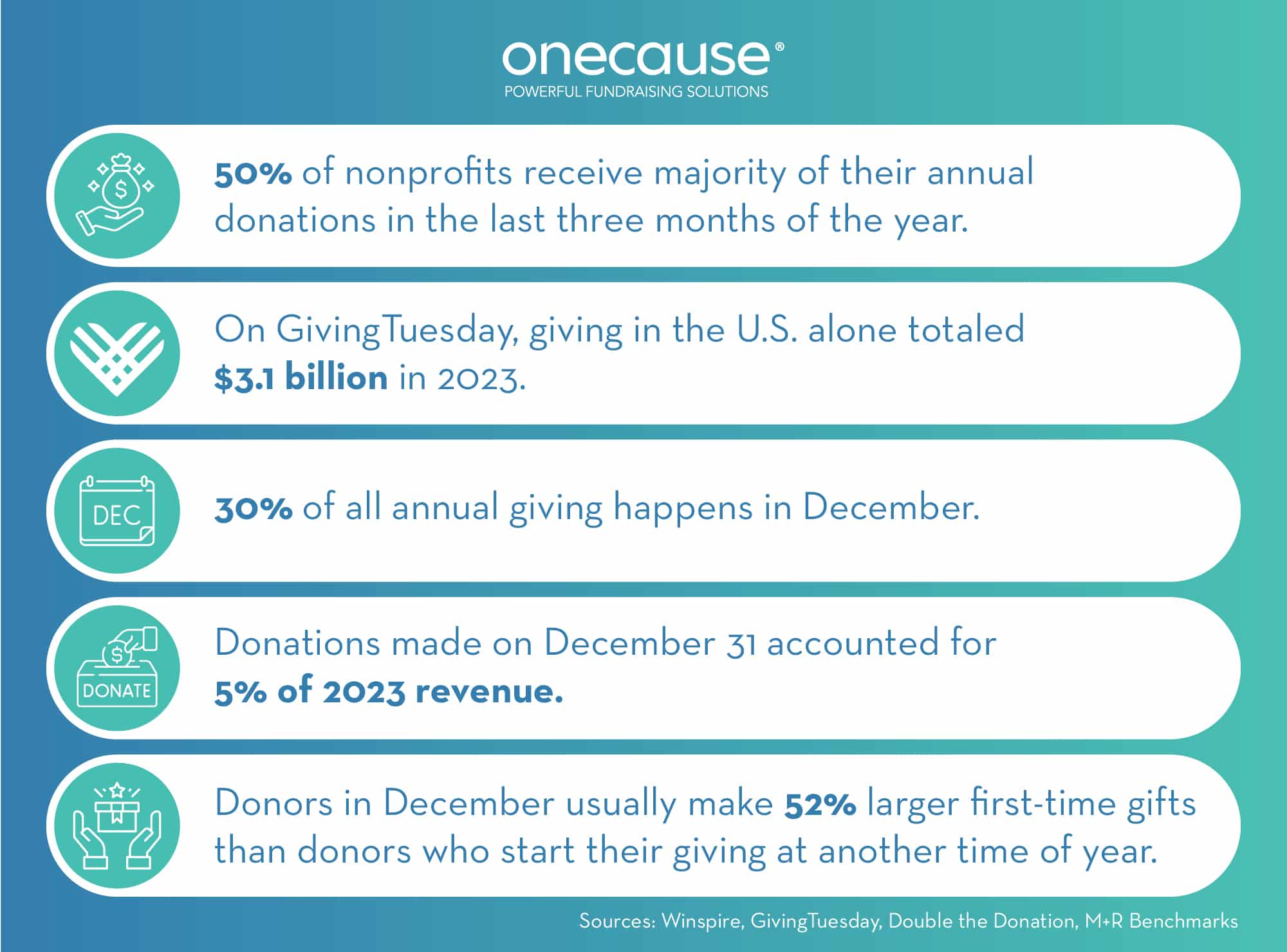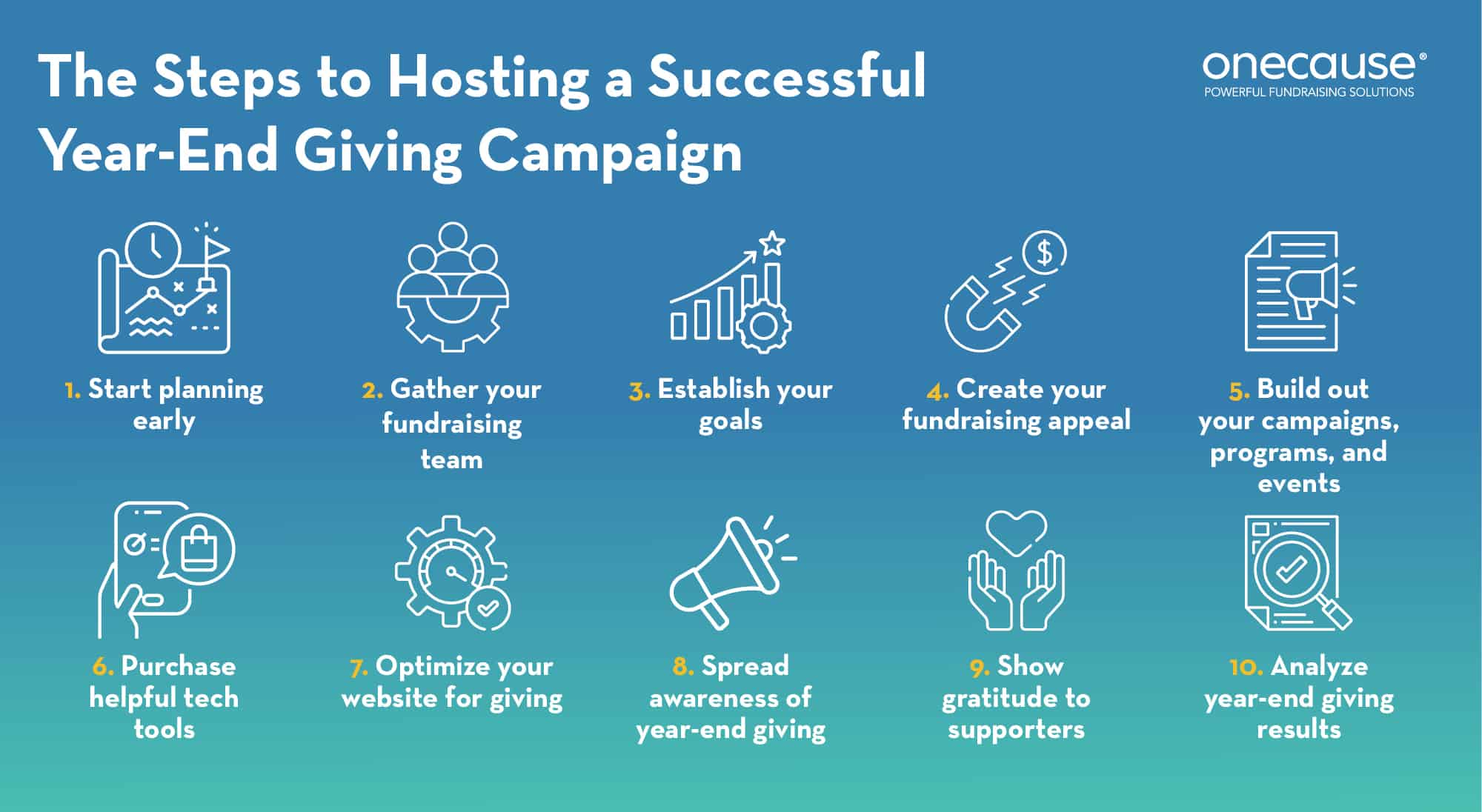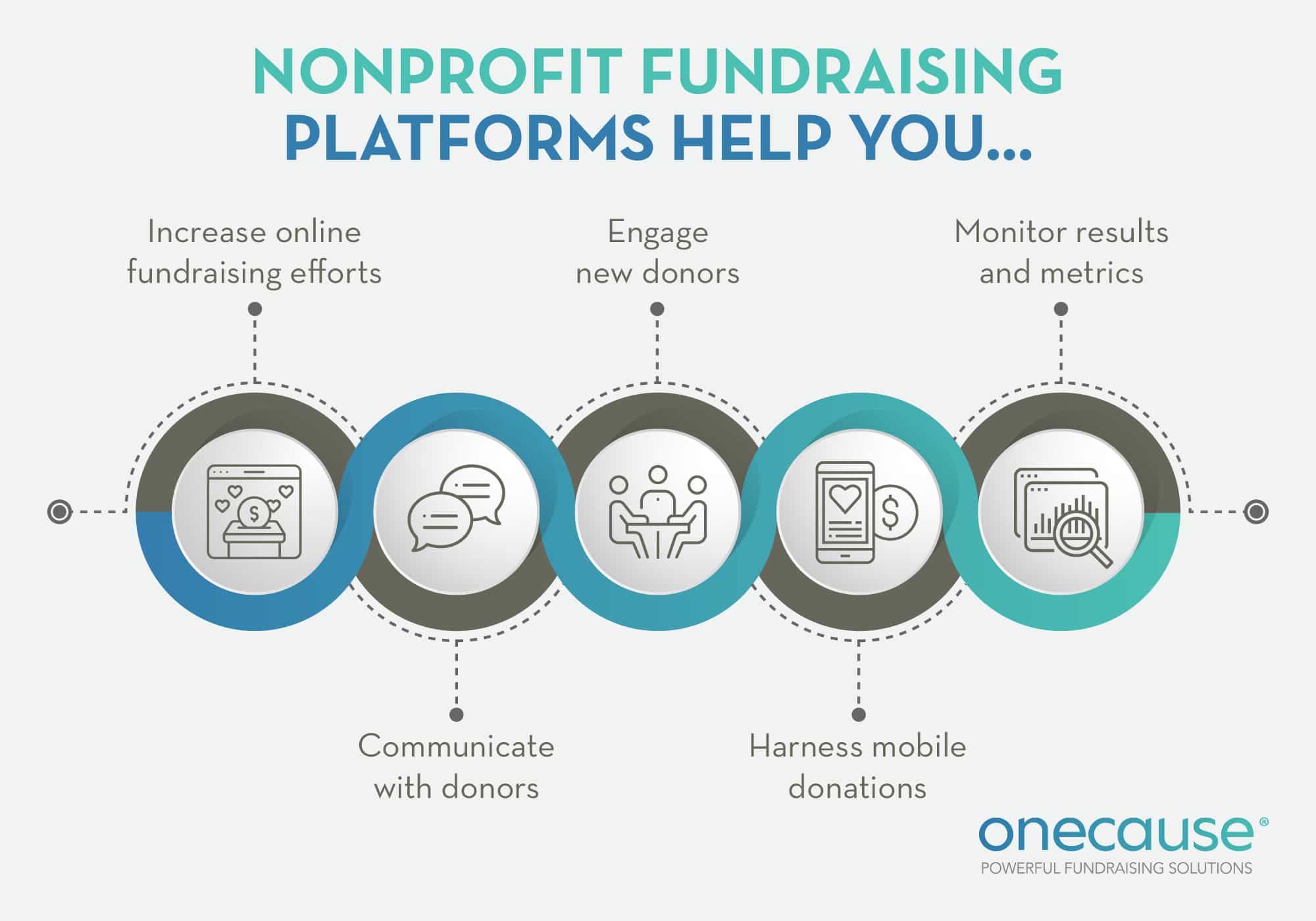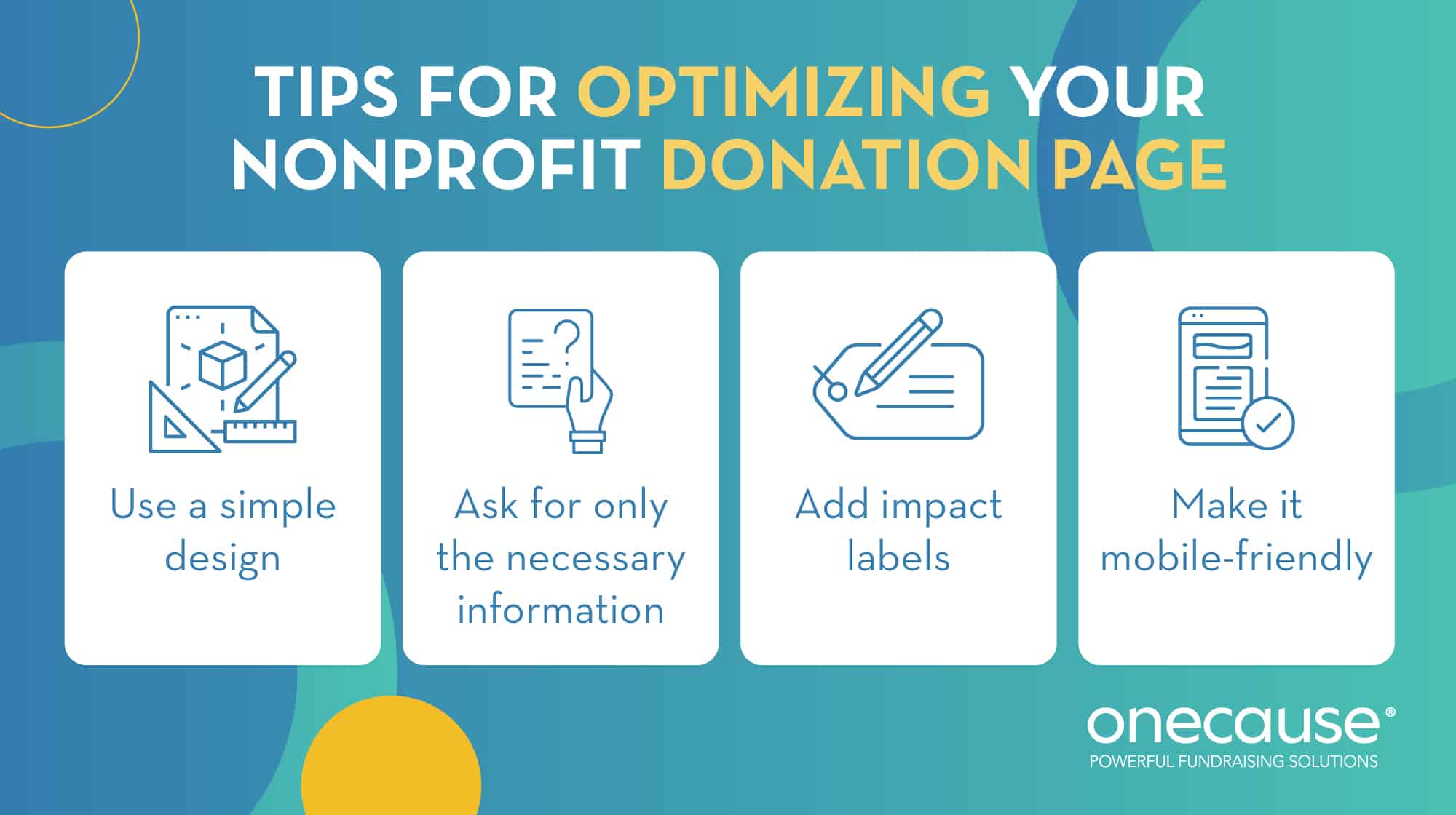Year-End Giving: The Ultimate Guide to Increase Donations
When most people think about the end of the year, they think of holidays, festivities, and gatherings with family. However, for nonprofits, the season is a hectic yet exciting time of increased generosity. If leveraged strategically, you can easily meet or exceed your organization’s annual fundraising goals during this energetic time.
To help you raise more, we’ve put together the ultimate guide to year-end giving. We’ll cover:
Let’s start by answering frequently asked questions about year-end giving!
Year-End Giving FAQs
Why is year-end giving important?
By the last quarter, you know whether you’re on track to meet your annual fundraising goals. This is the perfect time to buckle down and focus on one last big push to acquire the funding you need. Luckily, nonprofits experience heightened generosity from their supporters during year-end, making fundraising appeals even more effective.
Just take a look at these statistics:

- 50% of nonprofits receive most of their annual donations in the last three months of the year.
- On GivingTuesday, giving in the U.S. alone totaled $3.1 billion in 2023.
- 30% of all annual giving happens in December.
- Donations made on December 31 accounted for 5% of 2023 revenue.
- Donors in December usually make 52% larger first-time gifts than donors who start giving at another time of year.
Although supporters are donating more money to nonprofits at year-end than at any other time of year, it also means that more nonprofits will be clamoring for those funds. You must approach year-end giving thoughtfully and strategically to tap into the season’s increased philanthropy successfully.
What is a year-end giving campaign?
A year-end giving campaign is similar to any other fundraising campaign, except that it’s specifically designed to maximize donations during the last few months of the season. These campaigns can take many different forms, but they usually feature online fundraising to help the nonprofit reach a wider audience not limited by geographic location.
However, since year-end is also a time of holidays and festivities, some organizations also choose to host fundraising events. This is especially helpful for nonprofits with close-knit communities with members that all live in the same geographic area—for example, schools might find value in hosting a winter fundraising party for students and their families before everyone leaves on break.
Ultimately, the strategies you choose for your year-end giving campaign will depend on your nonprofit’s unique needs and audience.
Why do people donate at the end of the year?
There’s no one reason that people donate during year-end, but here are a few common reasons:
- Spirit of giving. Since year-end is a season filled with gift-giving, some individuals may be inspired to also give back to charitable organizations.
- Raises and bonuses. Many employers increase their employees’ pay at the end of the year, giving them more disposable income to spend on charitable gifts.
- Tax benefits. In the U.S., money donated to nonprofit organizations is tax-deductible. Some individuals may make a gift to reduce their taxable income and therefore their tax burden.
Be sure to approach year-end giving strategically to inspire gifts from your supporters, regardless of what their reason for donating is.
How do I get people who donate at the end of the year to keep giving into the next year?
Picture this: You’re at a holiday party and you strike up a conversation with an unfamiliar person. You have a good time chatting with them, so you exchange phone numbers. After the party is over, you wait to receive a text or a call. But it never comes. So, you assume that they aren’t interested in pursuing a friendship with you.
The same principle applies to your nonprofit. The key to securing recurring gifts from supporters is donor stewardship, defined as the process of building and maintaining relationships with donors. Ideally, you should already have a strategy established for your nonprofit. However, year-end giving preparations give you another opportunity to make improvements to it.
To learn more about this concept and apply it to your nonprofit, check out our guide to creating a sustainable stewardship strategy!
10 Steps to Hosting a Successful Year-End Giving Campaign
Now that you know why this season is so important for your nonprofit, let’s take a look at how you can host a successful year-end giving campaign.

1. Start planning your year-end giving campaign early
While planning and implementing end-of-year giving campaigns well in advance may seem like a no-brainer, nonprofits are usually scrambling this time of year to catch up on projected donations. This mad dash to the finish line can lead to poorly executed campaigns.
To keep things organized and ensure that your campaigns are successful, start planning early. We recommend that you follow this timeline:

- Summer and fall. During this time, you’ll plan your campaigns and map out timelines. This includes implementing new software, setting goals, and preparing your marketing strategy. Let your donors and new supporters know what’s coming soon with your year-end campaigns to spark conversation and build excitement.
- October. Get your year-end giving campaigns rolling with targeted marketing, sending out key information to the audience segments who would be most interested in them. If you’re hosting an event in the upcoming months, be sure to feature them in your materials.
- November. Your November campaigns should focus heavily on GivingTuesday. Aside from that, you can also leverage Black Friday and Cyber Monday by partnering with a local (or national) retailer and working out a donation as a percentage of purchases through a commercial coventure or cause marketing campaign. See if you can provide handouts, stickers, or other giveaways in-store for even more exposure.
- December. This month, use the holidays to your advantage. Christmas, Boxing Day, Hanukkah, and the lead-up to New Year’s Day are particularly crucial, as this is when giving is highest. Appeal to the altruistic message of the holiday season and update your social media presence to promote social sharing, ensuring you capture your audience’s interest.
- Spring. Year-end giving doesn’t stop once the new year starts. Take this valuable time to steward relationships by creating multiple touchpoints with supporters new and old. Start by thanking them for donating, then connect them to your mission with stories of your beneficiaries and the impact of their gifts.
This is what the best year-end giving campaigns can do: easily pivot into ongoing, yearlong conversations. Don’t view year-end campaigns as just a way to raise a large amount of donations at once. Look at it as a touchpoint to continue conversations with supporters and strengthen relationships year-round.
2. Gather your fundraising team
Planning a fundraising campaign means taking on a big task load, and year-end giving is no exception. Instead of allowing all responsibilities to rest on a single person’s shoulders, gather a fundraising team that will work together to ensure the campaign is a success.
When putting together your team, look for individuals who can fill these roles:
- Campaign manager. This individual will oversee the campaign at a high level and will be in charge of ensuring everyone is progressing according to the timeline.
- Fundraising strategist. Your fundraising strategist will develop and implement your overall year-end fundraising strategy.
- Financial manager. In many cases, you need to spend money to generate donations. A financial manager will manage your budget, track expenses, and ensure you don’t overspend to meet your goals.
- Marketing coordinator. A marketing coordinator will promote your fundraising efforts through all relevant marketing channels, including your website, social media pages, email, and more.
- Event planner. Whether you’ve decided to host an online auction or a walkathon, an event planner will nail down the details and ensure everything runs smoothly.
- Volunteer coordinator. You may turn to volunteers to help you with your year-end giving plans. A volunteer coordinator will handle recruiting, training, and management of your nonprofit’s volunteers.
Your nonprofit likely already has individuals who can fulfill these responsibilities. If not, consider hiring dedicated individuals to take on these tasks. Or, if hiring isn’t an option, source help from your nonprofit’s board members and recruit additional volunteers to provide the support needed.
3. Establish your year-end fundraising goals
Goal setting is a significant part of any nonprofit fundraising campaign, but it can be especially critical for year-end success. As you plan your campaign, have your team answer the following questions to help you set your goals:
- Where did our year-end revenue come from the previous year?
- How much growth is expected year-over-year?
- What goals do we have for existing donor gifts?
- What goals do we have for new donor gifts?
- What are our goals for matching gifts?
Deciding your goals early will help inform your year-end giving strategy, setting your team up for success. Don’t forget to assess how your year-end goals fit into the bigger picture of annual fundraising for your entire fiscal year. Are you counting on the end of the year to bring in the majority of donations? Or are you simply supplementing an already successful annual campaign?
After you’ve answered these questions, you’ll be ready to map out how you’ll engage with donors to ensure you have the maximum runway to drum up donor awareness and giving during the year-end.
4. Create your fundraising appeal
Although your nonprofit may have loyal supporters willing to give to your nonprofit repeatedly, it’s an entirely different story for individuals who have just stumbled across your organization’s website or social media page. You need to convince them that your nonprofit is worthy of their donations, and the best way is to put forth a meticulous fundraising appeal.
Your year-end fundraising appeal should:
- Communicate why your nonprofit needs donations. To help you do this, answer these questions: What problem is your nonprofit addressing? Why is that problem important? Why does your nonprofit deserve support more than other, similar organizations?
- Focus on the donor’s impact. Focus on what impact the donor will make by giving your nonprofit their hard-earned money, or what your nonprofit will do with the donations you receive. Let’s say a parent-teacher organization is trying to raise funds to host a prom event for high school seniors. They might frame it in their appeal like this: “With your donation, we can send off our graduating students with a party that celebrates their accomplishments and time at our school.”
- Form connections with storytelling. Use evocative language to add excitement to your appeal and secure emotional buy-in from supporters. Include details about the beneficiaries you’re helping, the obstacles they’ve faced, and how your aid has improved their lives. For instance, an animal shelter’s year-end giving appeal might include a picture of a cat and this line: “Help abandoned kittens like Peanut find their forever home by donating to our shelter this Christmas!”
Include a clear call to action (CTA) in your fundraising appeal. In this case, specify that you need the reader to donate to your nonprofit. By doing so, your supporters will clearly understand what you want them to do, making it easier for them to follow through on that action. Additionally, add links or QR codes to your donation page in your marketing materials to streamline the process further.
5. Build out your campaigns, programs, and events
Your nonprofit’s year-end giving team can bring together proven strategies to increase the success of your end-of-year campaigns. Get creative with your campaigns, programs, and events to entice supporters into giving to your organization.
Here are some ideas you can leverage for your year-end giving campaign:
GivingTuesday
GivingTuesday is an increasingly important part of the end-of-year fundraising cycle. Since 2012, this worldwide movement has raised millions for nonprofits and has made this single day a pivotal part of any team’s end-of-year plan.
As part of your GivingTuesday campaign, build a dedicated online giving site that provides information about the movement and a donation page for giving. Your team can house GivingTuesday content on this site throughout the year and encourage engagement by creating posts for supporters to share.
Don’t forget to send out marketing materials ahead of time as well to spread the word about this global day of giving—and let supporters know that donating to your campaign counts as their act of generosity for the day!
Social Media and Peer-to-Peer Fundraising
Build end-of-year campaigns that you and your supporters can share on social media. With over 5 billion people using social media, social sharing greatly increases the number of eyes on the message and the number of potential clicks on links. Plus, in today’s social media culture, many year-end campaigns have the potential to become viral, dramatically increasing donation amounts.
And, if you’re already maximizing social sharing, why not take it a step further with peer-to-peer fundraising? This type of campaign leverages your existing donor base to spread the word about your mission and find potential new donors across social media platforms. For end-of-year campaigns, especially around the holidays, peer-to-peer fundraising can be incredibly impactful as these campaigns are personal and emotionally engaging.
One-Time Events
More and more nonprofits host year-end fundraising events in conjunction with their campaigns to boost giving. Here are a few examples of events you might host at year-end:
- Holiday gala
- Winter charity auction
- Santa walk
- Christmas carol concert
- Holiday movie marathon
- New Year’s Eve party
Events that do make it on the books are often well attended and financially successful. They’re also the perfect opportunity to open the door to in-person engagement and interaction with donors.
6. Purchase an all-in-one tech tool to help with year-end giving and beyond
It might seem like you have insurmountable tasks ahead of you to have a successful year-end giving season. Luckily, technology is available to take off some of the pressure. In particular, nonprofit-specific fundraising software can help organizations work smarter and get more done on the backend so more donations can be raised on the front end.
Nonprofit fundraising platforms can help teams:

- Increase online fundraising efforts. With intuitive microsites, donation forms, and giving pages built specifically for individual campaigns, nonprofit teams can take the end of the year by storm without having to worry about conflicting messaging. Look for a secure online platform provider to make donating online and via mobile a breeze.
- Communicate with donors. Online fundraising platforms help nonprofit teams communicate and engage with current donors and new audience members to build strong, lasting relationships across all stages of a campaign—before it starts, during, and even after.
- Engage new donors via social engagement. With peer-to-peer fundraising software, nonprofits can harness the power of social fundraising to create online gamification campaigns, promote individual social fundraising programs, and increase awareness across new markets.
- Harness the power of mobile donations. From mobile-optimized giving pages to intuitive text-to-donate solutions, modern nonprofit fundraising solutions give donors the ability to easily access and engage with end-of-year giving campaigns regardless of where they are.
- Monitor results and metrics in real-time. Nonprofit leaders can understand the success of your campaigns and quickly share these insights with others on the team with campaign alerts, event tracking, and real-time attendee updates.
If you’re looking for a top provider who can turn year-end stress on its head, OneCause is ready to help. We have plenty of solutions that make giving easy, while increasing donations and delivering peace of mind.
7. Optimize your website for giving
Since online giving will be a cornerstone of your year-end giving strategy, it’s paramount that you make donating online simple for your supporters. The best way to do that is by optimizing your website—namely, adjusting your donation page to provide a streamlined giving experience.
Follow these tips to optimize your donation page:

- Use a simple design. Avoid confusing viewers with visually complicated elements or difficult wording. Instead, implement a simple and intuitive design that readers will understand.
- Ask for only the necessary information. While it’s tempting to get as much information about your donors as possible, save it for after they’ve made a donation. If your donation form is too long, people may get frustrated and choose not to donate.
- Add impact labels. Communicate the impact of donations by adding impact labels to each giving level. For example, an animal shelter might add a statement under their $20 donation option to say: “Your donation allows us to purchase enough food to feed a dog for two months.”
- Make it mobile-friendly. Some individuals may prefer to give on their mobile devices rather than desktop computers. Optimize your donation page for all devices to provide a good giving experience and capture as many gifts as possible.
Additionally, make it easy to navigate to your donation page. Add CTAs to the page and add links to it in your navigation menus. That way, after readers have looked through the rest of your website and are ready to make a gift, they know exactly where to go.
8. Spread awareness of year-end giving
Once your campaigns are ready to go, it’s time to let your donors know! It’s a best practice to communicate and engage with your donor network as soon as your campaigns are finalized to grow excitement.
Here are a few ways you can promote your year-end giving activities:
- Send out sneak peeks of any upcoming programs to target audiences.
- Unveil year-end giving programs early by sending emails to your donor base to boost excitement and get the ball rolling on donations.
- Recruit your most passionate supporters to help you spread awareness and raise more on social media.
- Educate audiences on the impact and importance of your charitable cause well before the end of the year.
- Be upfront about how individuals and corporations can engage with your organization during year-end.
- Use ‘urgency’ messaging like “One day only!” or “Last chance to donate” to spur last-minute donations.
Don’t neglect your social media strategy, either. We’ve mentioned before that year-end giving is a great time to promote your activities using social media platforms like Instagram, Facebook, and LinkedIn. Leverage the power of trending hashtags, mentions, and topics to get more eyes on your year-end giving campaigns and create more touchpoints with potential donors.
9. Show gratitude to supporters
As the donations begin rolling in, don’t forget to show appreciation toward your donors. You can do this in many ways, such as:
- Send a thank-you message along with their donation receipt.
- Put out a social media blast thanking everyone for donating so far and encouraging supporters to make a gift if they already haven’t.
- Shouting out particularly generous donors at your year-end fundraising event.
- Making phone calls to major donors and sponsors who gave during the year-end season.
- Send small gifts or tokens of appreciation to donors who gave above a certain level.
Even when you’re in the thick of year-end giving, you’d be remiss to not thank your supporters for their generosity. It’s okay if you’re too busy to muster anything more than a quick thank-you email during this time. However, once the season is over, make a bigger show of your gratitude. For example, host a donor appreciation event such as a dinner, strengthening your relationship with them and helping them connect more deeply with your mission.
10. Analyze year-end giving results
Outside of stewarding relationships, there’s still work to be done even when year-end is over and you’re in the new year. One of the best ways you can set yourself up for success is by analyzing your year-end giving results. Look at key performance indicators (KPIs) such as:
- Total funds raised
- Average and median gift size
- Number of donors
- Number of first-time donors
- Number of repeat donors
- Email engagement rates
- Social media engagement rates
- Marketing channel conversion rates
When examining the data, consider whether your results are satisfactory or if you can make improvements. If a KPI did better than expected, analyze your strategy in that area to see if there are any best practices you can implement for future campaigns. If one performed poorly, take steps to determine what adjustments you can make to see better results in the future.
Ultimately, taking this data-driven approach will not only help you improve your year-end fundraising performance but also empower you to enhance all your future programs.
Additional Resources to Help Nonprofits With Year-End Giving Campaigns
Any nonprofit can benefit from a more strategic approach to year-end fundraising, especially since giving is heightened during this period. As every organization’s needs and audiences are different, use these steps as a guideline for your year-end giving. Identify a strategy that best fits your unique nonprofit and allows you to leverage your supporters’ generosity.
If you want to learn more about nonprofit fundraising, check out these resources:
- How to Plan a Fundraising Event: 10 Steps to Raise More. Want to round out your year-end giving strategy with a fundraising event? Learn how to plan an impactful event that’s sure to generate the funds you need.
- Unlocking the Secret to Peer-to-Peer Fundraising Success. Leverage your existing supporters and encourage them to fundraise on your behalf with peer-to-peer fundraising.
- Top 12+ Nonprofit Fundraising Platforms to Explore. Ready to purchase a fundraising solution that will skyrocket giving for your nonprofit? Discover our top recommendations here.



